What is Viparita Dandasana (Inverted Staff Pose)?

Viparita Dandasana is also known as Inverted Staff Pose or Dwi Pada Viparita Dandasana, or Wheel Pose variation. This is a deep backbend yoga asana with heart-opening properties.
This pose will challenge your flexibility and help you build more strength in your advanced backbend yoga poses.
There is a possibility of hyperextending the shoulders and chest in this pose, so it is not considered beginner-friendly. Below you’ll find a guide for achieving the strength and flexibility needed to perform this asana without any physical harm.
Overview & Etymology
The name Viparita Dandasana comes from the Sanskrit words "Viparita" which means Inverted, "Danda" which means Staff, and "Asana" which means Posture.
This posture cannot be found in any ancient Hatha Yoga texts. But, Krishnamacharya's students Pattabhi Jois and B. K. S. Iyengar explained this asana in their yoga teachings and books.
This pose is usually known as a combination of Chakrasana (Wheel Pose), Purvottanasana (Upward Plank Pose), Matsyasana (Fish Pose), and Sirsasana (Headstand Pose).
Sanskrit Name: विपरीत दण्डासन Pronunciation: vi-puh-REE-tuh Dhan-daa-sana
Pose Type: Backbend and Heart-Opener Also known as: Inverted Staff Pose
Strengthens: Shoulders, Chest, Back, Legs, and Core
Stretches: Back, Chest, Shoulders, and Abdomen
Health Benefits of Viparita Dandasana
Tones your core and legs.
Relaxes and soothes the mind.
Improves flexibility in the spine.
Improves digestion and kidney function.
Enhances hormonal balance in the body.
Alleviates chronic pain in the lower back.
Helps to build muscle stability and mindfulness.
Helps in revitalizing the central nervous system.
Enhances lung capacity and breathing patterns.
Strengthens the core, back, legs, and shoulders.
Opens the chest muscles, which further activates the heart chakra.
When to Avoid Performing Viparita Dandasana
Avoid if you have had a recent injury or surgery.
Avoid if you have high blood pressure.
Avoid if you have severe heart problems.
Avoid if you are feeling out of breath.
Avoid if you’re experiencing menstrual cramps.
Avoid if you have headaches, eye strain, or spine discomfort.
Avoid if you are in the second or third trimester of your pregnancy.
How to do Viparita Dandasana (Inverted Staff Pose)
To perform the Inverted Staff Pose you’ll follow a four-phase action plan listed below in chronological order.
Part 1 - Preparatory Poses for Viparita Dandasana
Warm-up is essential to avoid any physical injury while practicing the Inverted Staff Pose. The following are three primary preparatory poses that help prepare you for the main asana practice:
1. Matsyasana (Fish Pose) - Inhale and sit in Hero Pose. Exhale and recline on your back. Now, lift only your chest and neck, making a deep arch in your mid-back.

Make sure your head is the only point of your upper body that is resting on the mat. No other part of your torso should touch the ground. Hold this pose for a minute or two by breathing normally.
2. Chakrasana (Wheel Pose) - This pose is an intermediate backbend asana, and it’s very close to the Inverted Staff Pose formation. Start by lying down on your back. Now, bend your legs and arms as you place them on the ground.
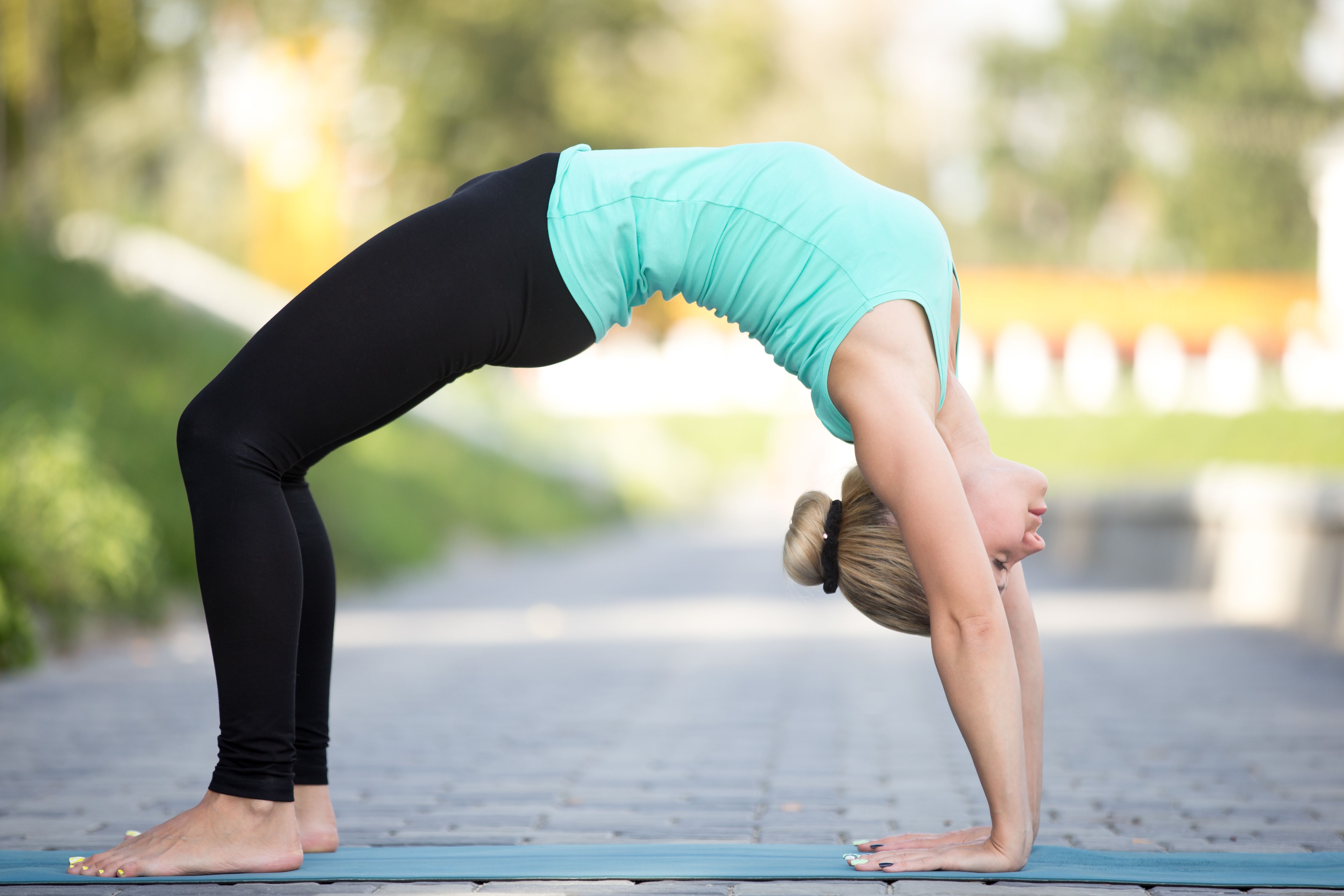
Inhale deep as you lift your pelvis first and then slowly lift up your head from the ground. Flex your shoulders and open up your chest muscles. Keep breathing and hold this pose for a few seconds, to as long as a couple of minutes if you feel comfortable doing so.
3. Purvottanasana (Reverse Plank Pose) - This pose is an intermediate backbend asana, and it’s also very close to the Inverted Staff Pose formation. Start by lying down on your back. Now, bend your legs and arms to place them on the ground.
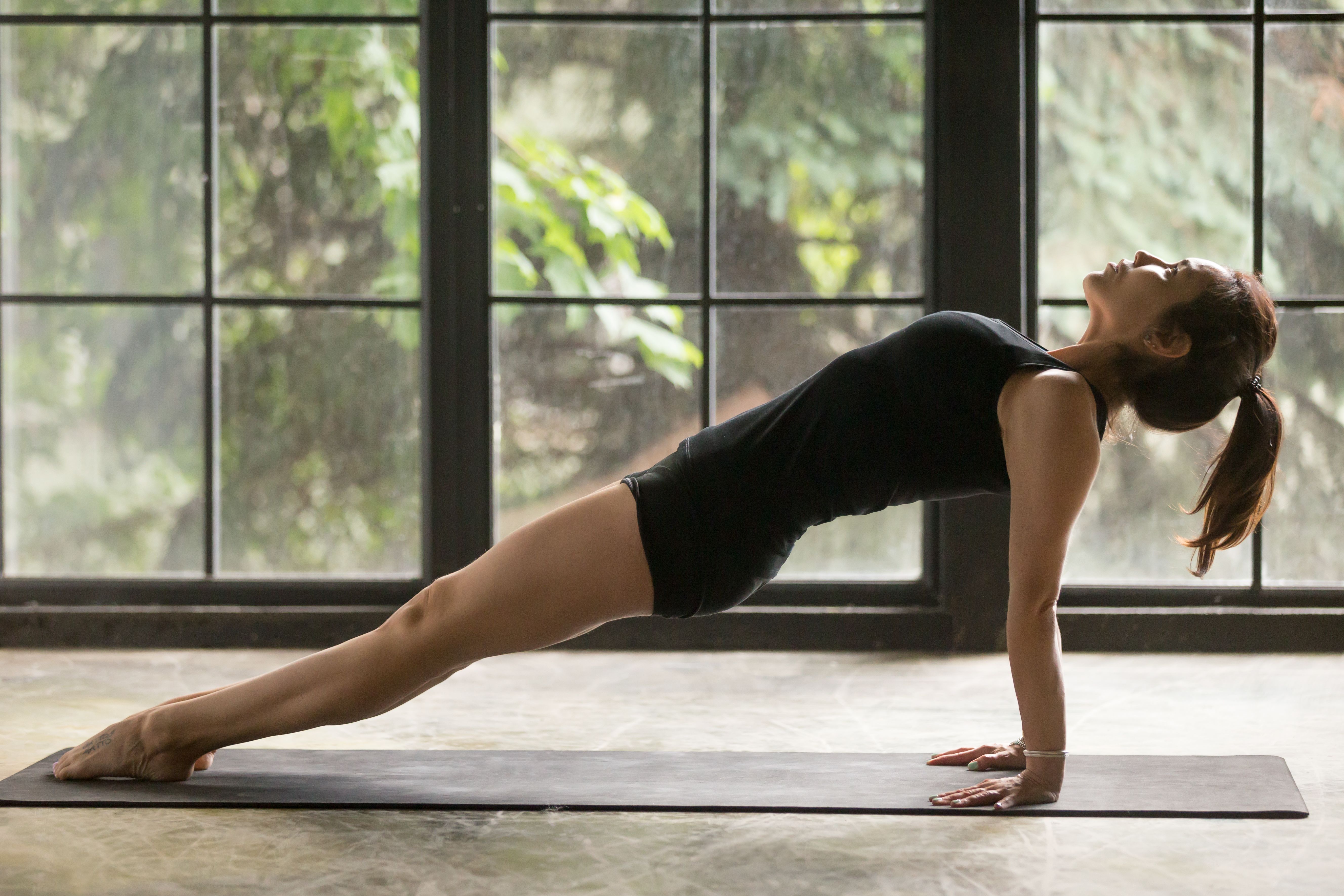
Inhale as you lift your pelvis first and slowly lift your head from the ground. Flex your shoulders and open up your chest muscles. Keep breathing and hold this pose for a few seconds to a minute.
Part 2: Step-by-Step Instructions to Perform Viparita Dandasana
Try the Inverted Staff Pose by following the steps below:
Step 1- Lie on your back and start from an Upward Bow Pose or a Full Wheel Pose.
Step 2- From the Full Wheel Pose, bend your arms and place them on the ground. Also, lower your head on the floor, cupping both the arms around your head. Make sure your fingers are interlaced behind your head.
Step 3- Here, tighten your core and shoulders, and focus on your breathing for one minute.
Step 4- With a powerful exhale, press your heels strongly into the mat and try to straighten your legs.
Step 5- As you straighten your legs, make sure to shift your pelvis, chest, and shoulder in the same direction as your head.
Step 6- Inhale to open up and expand your chest, with a deep tension in your low back. Hold this pose here with mindful breathing for a few seconds.
Step 7- Exhale and release the pose by bending your legs and lying back down on your back.
Breath Awareness:
Inhale while dropping your arms from Full Wheel to Half Wheel Pose.
Exhale as you press into your heels on the mat to straighten your legs.
Performance Duration for Beginners: Hold Viparita Dandasana for 30-60 seconds.
Performance Duration for Advanced: Hold Viparita Dandasana for 1 to 3 minutes.
Part 3: Things to Keep in Mind
If you are a beginner, these are some essential tips to keep in mind during your Inverted Staff Pose practice:
Do not over-stretch: Be careful not to overstretch in this pose because it can cause wear and tear to your muscles. Instead, you can keep the stretch minimal by maintaining a slight bend in your knees and not opening your chest completely.
Get assistance from a spotter: If you feel some instability in your Inverted Staff Pose ask a friend, teacher, or family member to spot you during your practice. They can correct your alignment, provide you with head support, and keep you safe from injury.
Part 4: Relaxing Poses After Viparita Dandasana
After such a challenging backbend pose, it’s crucial to counter-flex and bring your muscles back to their normal shape. Be sure to perform the following counter-poses after your Viparita Dandasana practice:
1. Savasana (Corpse Pose): As you lie back on the ground post-practice, relax in the Corpse Pose for 1 to 2 minutes. Relax like you are performing a deep sleeping meditation.

Close your eyes and scan your whole body for stress points, from your toes to your head. If you feel tension in any part of your body, simply focus on your breathing and release all your stress.
2. Ardha Halasana (Half Plow Pose): In continuation from the Corpse Pose, lift your legs up at a 90-degree angle to the ground.

Hold this pose here for 1 to 2 minutes in order to release any stress and tension around your tailbone.
3. Apanasana (Knees to Chest Pose): Move your legs from a Half Plow Pose into a knees bent formation. Now, lift your neck from the ground and try to touch your forehead to your knees.
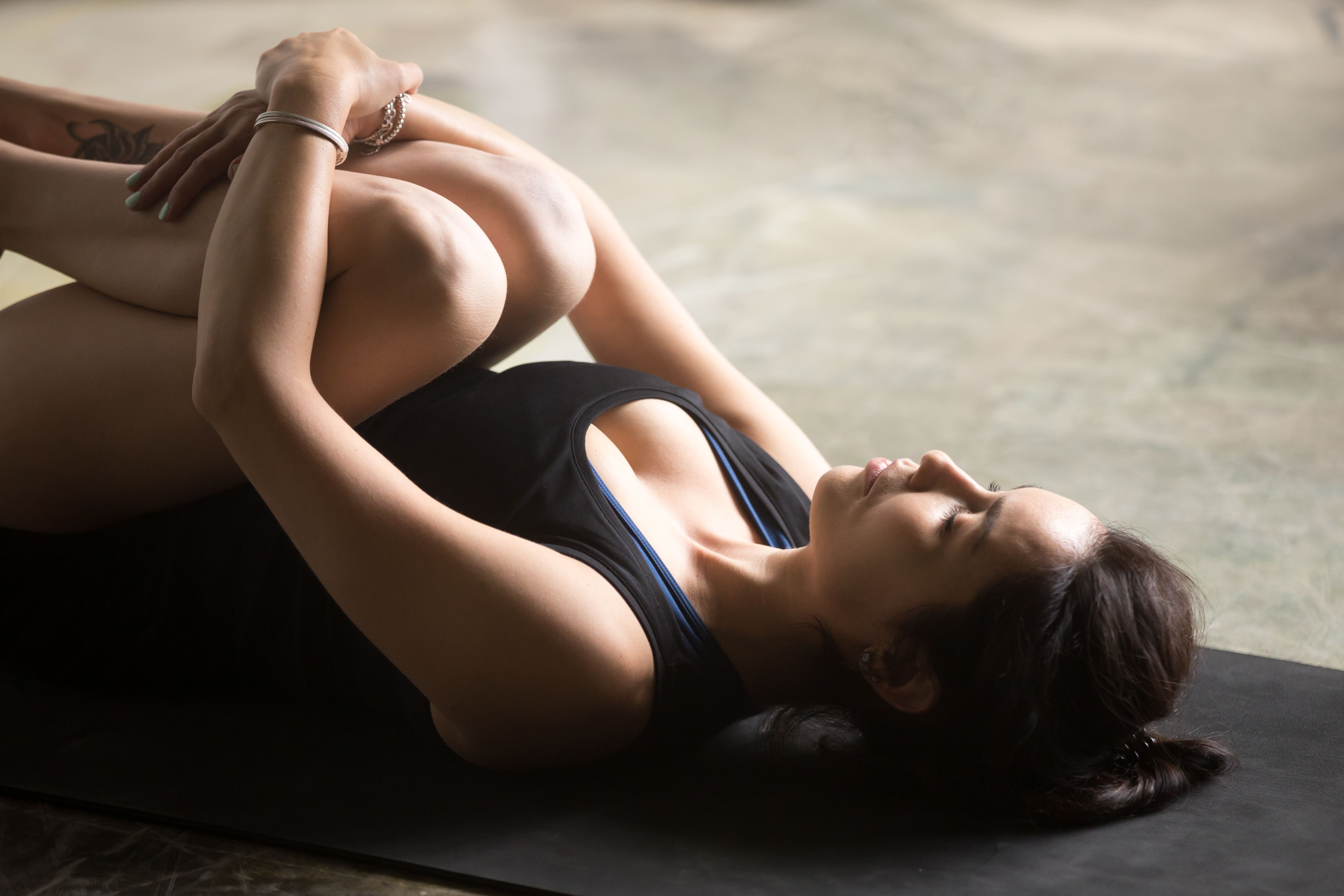
If you want, you can either hold this pose here for a few minutes or you can rock front and back in this position. This helps you relax your entire spinal column and allow your body to return to its normal shape.
Viparita Dandasana Variations to Consider
The following are a few posture variations for intermediate to advanced yoga practitioners who are ready for some more challenges:
1. Forearm Wheel Pose: Keep your legs bent in this pose because you will be using your neck, arms, and shoulders for stability. Make sure your head is not resting on the ground.
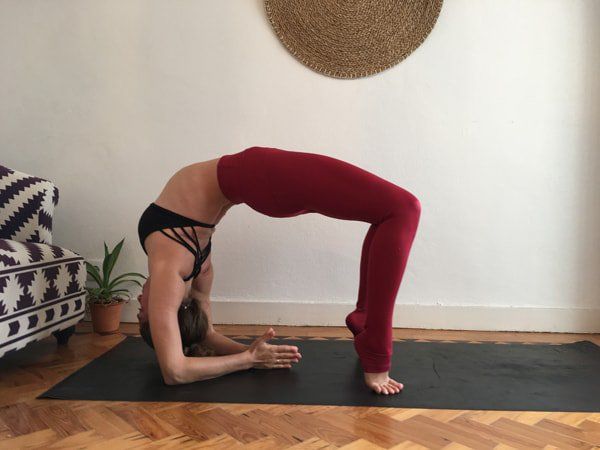
Rather than supporting your neck and head by interlacing your fingers behind your head, try to make a namaste formation and hold this pose here.
2. Half-Leg Up Inverted Staff Pose: From the previous variation, straighten your legs one by one. Hold your heels very tight to the ground and then apply the force from your heels.

Hold this variation for a few seconds and if your core is strong, then inhale deeply to lift one leg halfway up in the air. Release after a few seconds and repeat the same on the other side.
3. Straight-Legged Full Wheel Pose: Continuing from the last pose, inhale as you lift your arms off the ground and try to keep them straight. Root your heels strongly into the ground and push your pelvis, chest, and arms in one direction with the power of your heels.
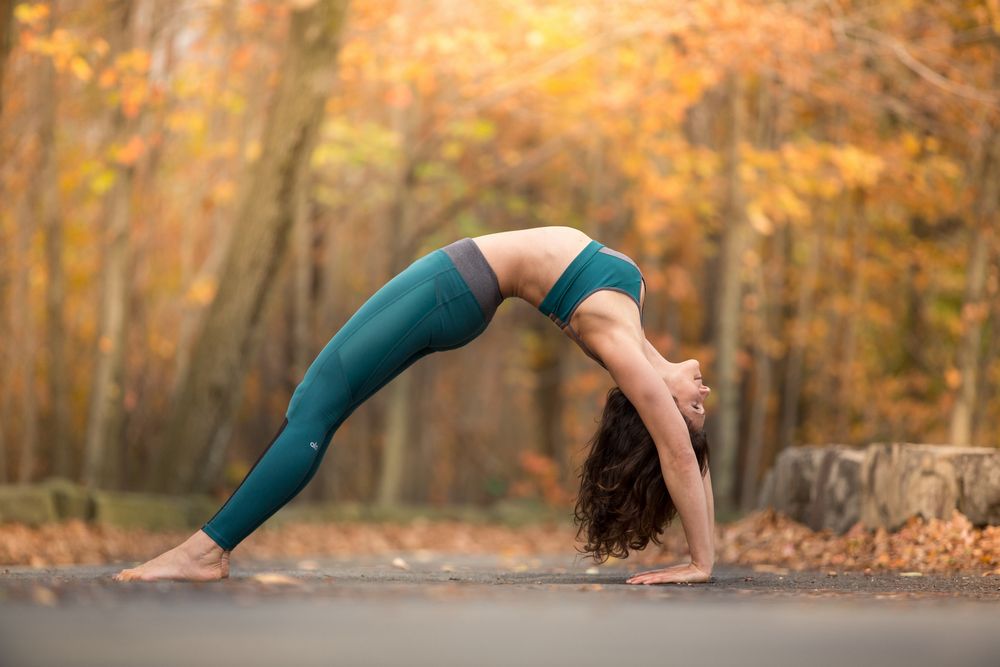
The more you push, the more your legs will straighten, the more your chest will open, and the deeper your low back will be flexed.

Enjoy a Free 1-on-1 Session with a Coach!
Receive personalized guidance tailored to your unique fitness goals, live with a dedicated coach—no credit card required.
Frequently Asked Questions about Viparita Dandasana
There are numerous variations for Viparita Dandasana that an intermediate or an advanced yogi can try. Such variations usually blend well with Wheel Pose — for example, One-Legged Inverted Staff Pose, Inverted Staff Pose with a yoga wheel, or Inverted Staff Pose with a gym ball.
Viparita Dandasana has the following health benefits:
- Strengthens your core.
- Increases flexibility in your spine.
- Open your chest and heart chakra.
- Alleviates shoulder, neck, and lower back pain.
- Helps in improving mindfulness and concentration.
- Activates smooth flow of hormones throughout the body.
To get into Dwi Pada Viparita Dandasana, follow the steps below:
1. From the complete Wheel Pose, get into a low wheel posture by bending your elbows and knees.
2. Inhale as you place your head on the ground and cup your elbows around it.
3. Exhale and now straighten your legs by pushing your pelvis, chest, and shoulders in the direction of your head.
4. Feel a deep bend in your low back and the muscles opening up in your chest. Hold this pose here.
Beginners should not perform Eka Pada Viparita Dandasana because it can be challenging to master in the first few attempts. There is a possibility that beginners could seriously injure themselves during their first attempt and should be practiced with a certified yoga instructor.
If you lack spine flexibility, your primary goal should be to build strength and flexibility in your spine for the first few months of your yoga practice. Then gradually, start with easy backbends like a Cobra, Bow, and Wheel Pose. Once you feel some confidence in your back bending postures, try Viparita Dandasana, and then move to Eka Pada Viparita Dandasana.
Viparita Dandasana Iyengar B. K. S. Iyengar's instructions on how to execute this posture in his book, "Light on Yoga."
Viparita Dandasana was not mentioned in any ancient yoga texts priorly. It was taught by a famous yoga scholar Guru Krishnamacharya to his students, B. K. S. Iyengar and Pattabhi Jois.
Later, Jois and Iyengar spread the word about this asana globally with their teaching and yoga books.



.webp)
%20(7).jpg)




